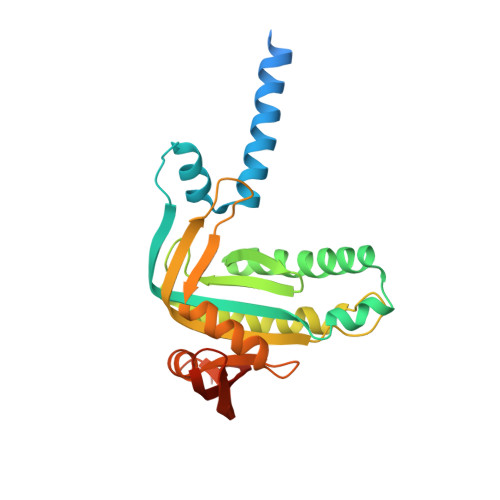Role of the nucleotidyl cyclase helical domain in catalytically active dimer formation.
Vercellino, I., Rezabkova, L., Olieric, V., Polyhach, Y., Weinert, T., Kammerer, R.A., Jeschke, G., Korkhov, V.M.(2017) Proc Natl Acad Sci U S A 114: E9821-E9828
- PubMed: 29087332
- DOI: https://doi.org/10.1073/pnas.1712621114
- Primary Citation of Related Structures:
5O5K, 5O5L - PubMed Abstract:
Nucleotidyl cyclases, including membrane-integral and soluble adenylyl and guanylyl cyclases, are central components in a wide range of signaling pathways. These proteins are architecturally diverse, yet many of them share a conserved feature, a helical region that precedes the catalytic cyclase domain. The role of this region in cyclase dimerization has been a subject of debate. Although mutations within this region in various cyclases have been linked to genetic diseases, the molecular details of their effects on the enzymes remain unknown. Here, we report an X-ray structure of the cytosolic portion of the membrane-integral adenylyl cyclase Cya from Mycobacterium intracellulare in a nucleotide-bound state. The helical domains of each Cya monomer form a tight hairpin, bringing the two catalytic domains into an active dimerized state. Mutations in the helical domain of Cya mimic the disease-related mutations in human proteins, recapitulating the profiles of the corresponding mutated enzymes, adenylyl cyclase-5 and retinal guanylyl cyclase-1. Our experiments with full-length Cya and its cytosolic domain link the mutations to protein stability, and the ability to induce an active dimeric conformation of the catalytic domains. Sequence conservation indicates that this domain is an integral part of cyclase machinery across protein families and species. Our study provides evidence for a role of the helical domain in establishing a catalytically competent dimeric cyclase conformation. Our results also suggest that the disease-associated mutations in the corresponding regions of human nucleotidyl cyclases disrupt the normal helical domain structure.
Organizational Affiliation:
Laboratory of Biomolecular Research, Division of Biology and Chemistry, Paul Scherrer Institute, 5232 Villigen, Switzerland.

















